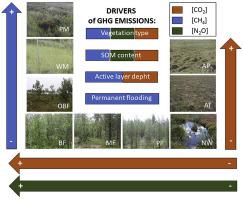Polar Science ( IF 1.5 ) Pub Date : 2020-05-11 , DOI: 10.1016/j.polar.2020.100531 Alessandra Lagomarsino , Alessandro Elio Agnelli

|
Understanding the drivers affecting SOM decomposition, GHG emissions and feedback to climate change in subarctic fragile and highly patterned landforms is crucial nowadays. A field campaign was conducted at catchment scale in Finnish Lapland, aiming at detecting differences in GHG fluxes in a mosaic of subarctic landforms: pine, mixed, birch and open birch forest, alpine tundra, alpine palsa, non-mire wetland, palsa mires and wetland mires. Soil profiles were described and analyzed for chemical and physical properties. CO2, CH4 and N2O fluxes from vegetated soil surface were measured by static chamber method.
The largest amount of CO2 was emitted by birch forests>palsa mires>tundra and pine forest>wetlands and was driven by organic layer thickness in palsas and by priming effect mechanisms when environmental conditions favored the mineralization of organic matter stored in birch forest. Depth and organic matter content of humified organic layer, vegetation development and permanent flooding conditions triggered CH4 emissions, with 6-fold higher emissions from wetland than palsa mires and net uptake in the other landform types. N2O emissions in tundra and birch forests derived mainly from nitrification, sustained by oxygen and N availability. Differently, the higher C/N ratio and lower pH in pine and mixed forests caused N2O uptake in the soil.
Possible feedbacks to climate change in the next few years or decades were identified: i) huge CH4 emissions in case of seasonally frozen soil or permafrost disappearance and ii) an increase of CO2 and N2O emissions in response to birch forest expansion.
中文翻译:

芬兰北部拉普兰地区植被覆盖和土壤特征对CO 2,CH 4和N 2 O通量的影响
如今,了解影响北极地区脆弱和高度格局化地貌中SOM分解,GHG排放以及对气候变化的反馈的驱动因素至关重要。在芬兰拉普兰的集水区范围内开展了一场野外活动,旨在发现亚北极地貌马赛克中的温室气体通量的差异:松树,混合桦树和开阔桦树森林,高山苔原,高山帕尔萨,非沼泽湿地,帕尔萨沼泽和湿地泥潭。描述并分析了土壤剖面的化学和物理性质。通过静态室法测量了植被土壤表面的CO 2,CH 4和N 2 O通量。
桦树森林>帕尔萨沼泽>苔原和松林>湿地排放的CO 2量最大,并且由棕榈树中的有机层厚度和环境条件有利于桦树森林中存储的有机物矿化的启动机制所驱动。腐殖质有机层的深度和有机质含量,植被发育和永久性洪涝条件触发了CH 4排放,其中湿地的排放量比其他沼泽地的帕尔萨沼泽和净吸收量高6倍。苔原和桦树森林中的N 2 O排放主要来自硝化作用,并由氧气和氮的有效利用来维持。不同的是,松树林和混交林中较高的C / N比和较低的pH导致N 2O在土壤中的吸收。
在接下来的几年或几十年中,已经确定了对气候变化的可能反馈:i)如果季节性冻结的土壤或永冻土消失,CH 4的排放量很大; ii)桦木林扩张导致CO 2和N 2 O排放量增加。











































 京公网安备 11010802027423号
京公网安备 11010802027423号